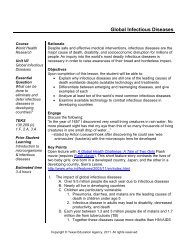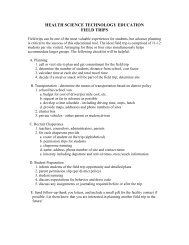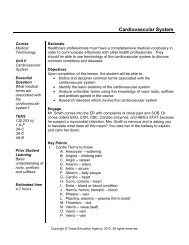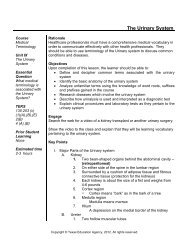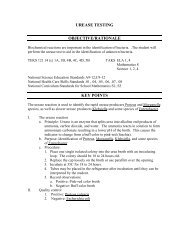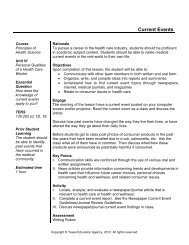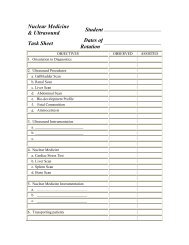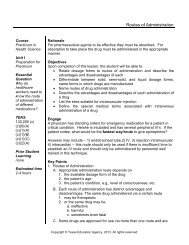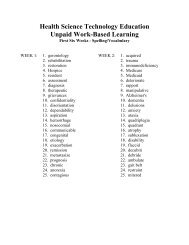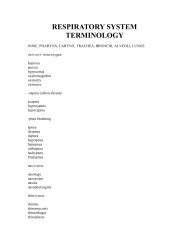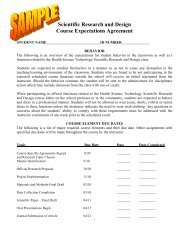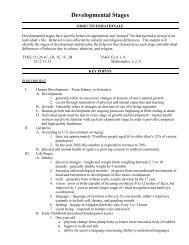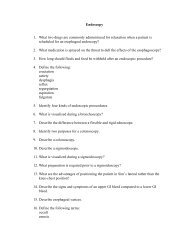Maslow's Hierarchy of Human Needs - Texas Health Science!
Maslow's Hierarchy of Human Needs - Texas Health Science!
Maslow's Hierarchy of Human Needs - Texas Health Science!
- No tags were found...
You also want an ePaper? Increase the reach of your titles
YUMPU automatically turns print PDFs into web optimized ePapers that Google loves.
Maslow’s <strong>Hierarchy</strong> <strong>of</strong> <strong>Human</strong> <strong>Needs</strong><br />
Course<br />
Principles <strong>of</strong><br />
<strong>Health</strong> <strong>Science</strong><br />
Unit VIII<br />
<strong>Human</strong> Growth<br />
and<br />
Development<br />
Essential<br />
Question<br />
What are our<br />
basic needs as<br />
a human being<br />
TEKS<br />
130.202 (c) 1I<br />
Prior Student<br />
Learning<br />
None<br />
Estimated time<br />
1-2 hours<br />
Rationale<br />
In order to have an understanding <strong>of</strong> human behavior it is important to<br />
realize that each person is motivated by needs.<br />
Objectives<br />
Upon completion <strong>of</strong> this lesson, the student will be able to:<br />
Understand Maslow’s <strong>Hierarchy</strong> <strong>of</strong> human needs<br />
Identify human needs according to Maslow’s <strong>Hierarchy</strong> <strong>of</strong> <strong>Human</strong><br />
<strong>Needs</strong><br />
Recognize that all human beings have basic needs<br />
Identify personal needs, especially aesthetic and self-actualization<br />
Engage<br />
Ask the students what they are motivated by:<br />
Money<br />
Friends<br />
Being accepted by peers<br />
What else<br />
Key Points<br />
I. NEEDS – a lack <strong>of</strong> something required or desired. <strong>Needs</strong> motivate us to<br />
act! Maslow defined a <strong>Hierarchy</strong> <strong>of</strong> <strong>Human</strong> <strong>Needs</strong> that stated that the<br />
lower needs must be met before an individual can strive to meet higher<br />
needs.<br />
A. PHYSIOLOGICAL -- necessary for life; unmet, these needs<br />
lead to death<br />
1. food<br />
2. water<br />
3. oxygen<br />
4. sleep<br />
5. protection from extreme temperatures<br />
6. elimination<br />
7. sensory needs - hearing, seeing, feeling, tasting, and<br />
mental stimulation<br />
8. motor needs - if muscles are not stimulated, they will<br />
atrophy<br />
B. SAFETY/SECURITY<br />
1. the need to be free from anxiety and fear<br />
2. the need to be secure in the environment<br />
3. the need for order and routine<br />
C. LOVE and AFFECTION<br />
1. social acceptance, friendship, to be loved<br />
Copyright © <strong>Texas</strong> Education Agency, 2012. All rights reserved.
II.<br />
2. need to belong, to relate to others<br />
3. sexuality<br />
a. a person's feelings/attitude toward their<br />
masculine/feminine nature<br />
b. the ability to give and receive love and affection<br />
c. reproductive capabilities<br />
D. ESTEEM -- feeling important and worthwhile - includes respect,<br />
approval, appreciation<br />
1. engagement in activities that bring achievement, success,<br />
and recognition<br />
2. growth <strong>of</strong> self-confidence which directs our actions toward<br />
becoming what we WANT to be<br />
E. SELF-ACTUALIZATION -- self-realization; obtaining our full<br />
potential; becoming confident, eager to express our beliefs, with<br />
a willingness to reach out to others to help them<br />
TO MEET OUR HUMAN NEEDS - we usually learn what works by<br />
trial-and-error<br />
A. Direct methods:<br />
1. hard work<br />
2. setting realistic goals<br />
3. cooperating with others<br />
4. evaluating effectively<br />
B. Indirect methods: unhealthy when used too <strong>of</strong>ten, but<br />
sometimes allows us to cope!<br />
1. suppression<br />
2. projection<br />
3. denial<br />
4. rationalization<br />
5. compensation<br />
C. When defense mechanisms are inadequate, stress reactions<br />
develop:<br />
1. chronic complaining and demanding behavior<br />
2. agitation with manipulative behavior<br />
3. restlessness<br />
4. sleeplessness<br />
5. depression - be alert for potential suicide<br />
6. withdrawal<br />
D. TO MEET THE NEEDS OF OTHERS -- personalized health<br />
care focuses on the patient, and meeting their needs and<br />
expectations<br />
E. CHALLENGES:<br />
1. meet each patient's needs to the best <strong>of</strong> your ability<br />
2. set standards <strong>of</strong> excellence for yourself<br />
3. sometimes only you will know (i.e. sterile field)<br />
4. let your conscience be your guide<br />
5. anything less than 100% is not acceptable<br />
Copyright © <strong>Texas</strong> Education Agency, 2012. All rights reserved.
F. RESPONSIBILITIES:<br />
1. take advantage <strong>of</strong> the opportunity to learn, develop basic<br />
skills, see the purpose <strong>of</strong> each assignment<br />
2. set your standards for your performance<br />
a. is 70% good enough <br />
b. establish study habits that work best for you<br />
c. relate learning to past experience<br />
d. measure each achievement in terms <strong>of</strong> progress<br />
toward your career goal<br />
3. be honest with yourself and take responsibility for your<br />
own actions<br />
Activity<br />
I. Complete the Maslow’s <strong>Hierarchy</strong> <strong>of</strong> <strong>Human</strong> <strong>Needs</strong> Quiz.<br />
II. Complete Maslow’s <strong>Hierarchy</strong> Of <strong>Needs</strong> Activity. (Teacher Guidelines)<br />
Assessment<br />
Key - Maslow’s <strong>Hierarchy</strong> <strong>of</strong> <strong>Human</strong> <strong>Needs</strong> Quiz<br />
Completion <strong>of</strong> Maslow’s <strong>Hierarchy</strong> <strong>of</strong> <strong>Needs</strong> Activity<br />
Materials<br />
Maslow’s <strong>Hierarchy</strong> <strong>of</strong> <strong>Needs</strong> Graphic<br />
Colored construction paper<br />
Various songs<br />
Accommodations for Learning Differences<br />
For reinforcement, the student will design a poster depicting Maslow’s<br />
<strong>Hierarchy</strong> <strong>of</strong> <strong>Needs</strong>.<br />
For enrichment, the student will research and report on Dr. Maslow and his<br />
<strong>Hierarchy</strong> <strong>of</strong> <strong>Needs</strong>.<br />
National and State Education Standards<br />
National <strong>Health</strong> <strong>Science</strong> Standards<br />
HLC01.01 <strong>Health</strong> Care Workers will know the academic subject<br />
matter required (in addition to state high school graduation<br />
requirements) for pr<strong>of</strong>iciency within their area. They will use this<br />
knowledge as needed in their role.<br />
TEKS<br />
130.202(c)(1)(I) identify human needs according to <strong>Maslow's</strong> <strong>Hierarchy</strong> <strong>of</strong><br />
<strong>Human</strong> <strong>Needs</strong><br />
<strong>Texas</strong> College and Career Readiness Standards<br />
English/Language Arts Standards<br />
Copyright © <strong>Texas</strong> Education Agency, 2012. All rights reserved.
II Reading<br />
B. Understand new vocabulary and concepts and use them accurately<br />
in reading, speaking, and writing.<br />
III Speaking<br />
A. Understand the elements <strong>of</strong> communication, both in informal group<br />
discussions and formal presentations, (e.g. accuracy, relevance,<br />
rhetorical features, and organization <strong>of</strong> information).<br />
B. Develop effective speaking styles for both group and one-on-one<br />
situations.<br />
IV. Apply listening skills as an individual and as a member <strong>of</strong> a group<br />
in a variety <strong>of</strong> settings, (e.g. lectures, discussions, conversations, team<br />
projects, presentations, interviews).<br />
Copyright © <strong>Texas</strong> Education Agency, 2012. All rights reserved.
Maslow’s <strong>Hierarchy</strong> <strong>of</strong> Basic <strong>Needs</strong> Quiz<br />
Match the correct level with the letter <strong>of</strong> the need.<br />
A. Physiological Need<br />
B. Safety Need<br />
C. Social Need<br />
D. Esteem Need<br />
E. Self-Actualization Need<br />
_________ 1. I’m starving.<br />
_________ 2. Please lock the door.<br />
_________ 3. I hope I won’t get fired for that mistake.<br />
_________ 4. I will succeed with that new program.<br />
_________ 5. I wish they would invite me to go to lunch.<br />
_________ 6. I want to chair that committee.<br />
_________ 7. Those people in that <strong>of</strong>fice are just mean.<br />
_________ 8. I hope they think my idea was good.<br />
_________ 9. I know I can be class president.<br />
_________ 10. I’m exhausted.<br />
Copyright © <strong>Texas</strong> Education Agency, 2012. All rights reserved.
KEY - Maslow’s <strong>Hierarchy</strong> <strong>of</strong> Basic <strong>Needs</strong> Quiz<br />
Match the correct level with the letter <strong>of</strong> the need.<br />
A. Physiological Need<br />
B. Safety Need<br />
C. Love and Affection Need<br />
D. Esteem Need<br />
E. Self-Actualization Need<br />
____A_____ 1. I’m starving.<br />
____B_____ 2. Please lock the door.<br />
____B_____ 3. I hope I won’t get fired for that mistake.<br />
____E_____ 4. I will succeed with that new program.<br />
____C_____ 5. I wish they would invite me to go to lunch.<br />
____D_____ 6. I want to chair that committee.<br />
____C_____ 7. Those people in that <strong>of</strong>fice are just mean.<br />
____D_____ 8. I hope they think my idea was good.<br />
____E_____ 9. I know I can be class president.<br />
____A_____ 10. I’m exhausted.<br />
Copyright © <strong>Texas</strong> Education Agency, 2012. All rights reserved.
Maslow’s <strong>Hierarchy</strong> <strong>of</strong> <strong>Needs</strong><br />
Instructor Guidelines<br />
1. Students receive the following scenario:<br />
You are being sent into a bubble to live for one year. Make a list <strong>of</strong> 25 things<br />
you will need to take with you to survive.<br />
Students will ask many questions, but the only information they can receive is the above<br />
statement.<br />
2. When finished, students are to turn the paper over on desk and cannot add to the list. Some<br />
will not be able to think <strong>of</strong> 25 things.<br />
3. Make a recording <strong>of</strong> 10-12 different songs. Record about 5 – 10 seconds <strong>of</strong> each song with<br />
several seconds between. You can use classical, country, oldies, rock and roll, rap, pop,<br />
and heavy metal.<br />
4. As the music is played, students write down the emotion or feeling they have as they are<br />
listening to the music.<br />
5. Discuss how important music is to survival, how many hours a day are spent listening to<br />
music, and discuss how fulfilling life would be without music.<br />
6. Students turn their papers over and with a show <strong>of</strong> hands see how many included music on<br />
their list.<br />
7. Break into groups and each group is given a packet <strong>of</strong> colors. I use construction paper and<br />
cut them in strips using black, white, the primary colors, and a few others. First, they write<br />
down how each color makes them feel, what mood it represents individually. Then they<br />
discuss their observations as a group.<br />
8. Discuss the observations, as a class focusing on how important color and art are to us<br />
everyday. Students then review their lists to see if they included color or art as existence<br />
without color is discussed.<br />
9. As a class, review the lists placing each need into one <strong>of</strong> the categories <strong>of</strong> the pyramid.<br />
10. As you talk about self-fulfilling needs – goals and ideals that motivate us -- students write<br />
down three goals: one for the end <strong>of</strong> the semester, one for the end <strong>of</strong> the school year, one<br />
for five years from now, and draw a picture <strong>of</strong> how they feel about themselves at this time.<br />
The students seal the goals in an envelope with their name on it, and return to the teacher.<br />
Keep them until the middle <strong>of</strong> May, and then return them. Keep all the envelopes from the<br />
1 st and 2 nd semesters and return them in May.<br />
Copyright © <strong>Texas</strong> Education Agency, 2012. All rights reserved.
Maslow’s <strong>Hierarchy</strong> <strong>of</strong> <strong>Needs</strong><br />
Self<br />
-<br />
Actualization<br />
Esteem<br />
Belongingness<br />
and<br />
Love<br />
Safety<br />
Physiological<br />
Copyright © <strong>Texas</strong> Education Agency, 2012. All rights reserved.



